#Cognitive Functions
Explore tagged Tumblr posts
Text
#credit: apoc4lyqse#edit#intj#my mbti#i have learned about#cognitive functions#me core#me coded#aesthetic#my aesthetic#dark academia#dark academia aesthetic#classic academia#chaotic academia#chill#cozy#vibes#mood#tv shows#movies#girlblogging#girl blogger
60 notes
·
View notes
Text
Here’s the link to the actual paper. For interested parties. The authors were even kind enough and savvy enough to include a TLDR. So maybe go read what they have to say. 
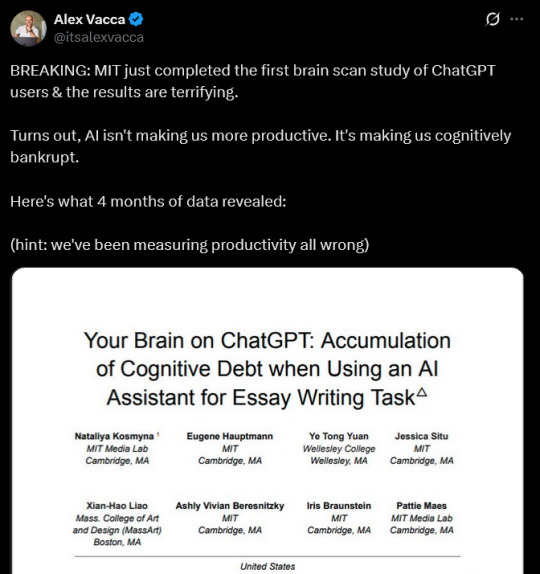
46K notes
·
View notes
Text

As an ENTP, internally screaming "AHHHHH" 24/7 is an accurate depiction of my life.
161 notes
·
View notes
Text
mbti tertiary functions (boredom functions)
INFJ/ISFJ: true crime, scrolling through wikipedia for hours, looking up riddles, scrolling through "onlyjayyus" tiktok, has a huge duolingo streak
ENFJ/ENTJ: uses se to support te/fe ambitions (sports, performing arts, community service, cleaning)
ESFJ/ESTJ: fantasizing, vision boards on pinterest, adding items to amazon wishlist, makes a bucket list for the year,
ESTP/ENTP: touches grass, hangs our with friends, class clown, watches reality tv, starts drama for no reason, debates on the internet (or fights irl if you're an estp 👀)
ESFP/ENFP: random urge to organize computer, random internet debates, creates new playlists, watches video essays about random topics, argues with friends about either stupid or smart things
INFP/INTP: reminisces about things. procrastinates. overthinking past conversations in the shower. collects cool rocks. photography. listens to the same song over and over again.
ISFP/ISTP: planning and...stuff. zodiac, psuedoscience, etc. strategic/world building video games, has a whole fictional world planned out in their head.
INTJ/ISTJ: "write in their feelings diary" 💀 IM SORRY, introspection, often known as super "self aware" as a result, watches nostalgic or comfort movies
#mbti#mbti memes#mbti personalities#mbti types#mbti personality types#infp#infj#intp#entp#intj#entj#enfp#enfj#istp#cognitive functions#16 personalities#esfj#estj#isfp#esfp
2K notes
·
View notes
Text
















The 16 types as things they love
Follow me on Instagram, Facebook, Twitter, YouTube and everything else @mbtitime and @typefy
#infp#infj#enfp#enfj#16 personalities#16 personality types#16 personalidades#intp#intj#entp#entj#istp#istj#isfp#isfj#esfp#esfj#estp#estj#myers briggs#carl jung#cognitive functions
513 notes
·
View notes
Text
MBTI Color Palettes
Just color palettes I associate with each type. Just for fun.
INTJ

ENTJ

INTP

ENTP

INFJ

ENFJ

INFP

ENFP

ISTJ

ESTJ

ISFJ

ESFJ

ISTP

ESTP

ISFP

ESFP

___
MBTI notes
#mbti#colors#color palette#typology#cognitive functions#myers briggs type indicator#myers briggs#intj#entj#intp#entp#infj#enfj#infp#enfp#istj#estj#isfj#esfj#istp#estp#isfp#esfp
833 notes
·
View notes
Text

Brain Cog Volume. 1
Here's the rest of the comic ^_^ So sorry for the long wait I got a lot of things going on IRL and forgot to post the rest of this :')
Enjoy the comic! I know it's something simple and sweet but this is a project for my Comic class. PART 1 / PART 2









#mbti#main functions#Brain Cog#User#Comic#cognitive functions#intj#art#myers briggs#te#mbti art#ni#fi#se#original character#oc
74 notes
·
View notes
Text
xNTxs with a hot take:

#even when they're wrong#or maybe when we're wrong#entp#intp#intj#entj#rationals#personality#personality type#mbti#cognitive functions#ne#ti#te#ni#meyers briggs
757 notes
·
View notes
Text
THE DIFFERENCE BETWEEN THE VOID STATE AND THE VOID:
tag: @aestheticlizalis
As always, I will love to hear your thoughts! and if you have any questions, I will be more than happy to answer them! If you liked it, leave a comment or reblog (that is always appreciated!). if you are intrested in more method check the masterlist!

Every time I end up talking about the void state, there is a part of me that tends to raise awareness about the void itself. It is a thing the void does not help you manifest, like the void state. In this post, I will try my best to explain how much these two things are truly different.
WARNING: COGNITO HAZARD (For those who do not know, a cognito hazard is a term used to describe an image, pattern, sound, or any other kind of sensory signal that directly causes harmful or undesired physiological or physical effects to one who senses or perceives it. (It is specifically used as a warning when talking about "forced awakening" things like the void.)
You are free to believe or not believe every word I will say in this post, and you are free to not believe every word I say. If, while reading this, you start to feel a negative emotion or a sensation as if you are lost or bodily or emotionally sick, DO NOT CONTINUE READING.

let's get deeper in this rabbit hole shall we?
i will talk breefly about the void state and then i will get in a more detailed way into what the void is, just because i aready explained the void state many times.
the void state:
is a state of deep meditation where you feel like floating and feel nothingness embodies you, making you feel one with the universe helping you to manifest. (Click the name if you actually want to know more.)
the void:
The void is nothing and everything at the same time. Let me explain better: the void is a place where everything is possible and exists, but at the same time is impossible and does not exist. The thing is, the void in itself is a pass to every other dimension because every dimension resides in the void, even the cursed ones or the ones that never will be or never were timelines. As a person with a lot of experience in the void itself, I will tell you that it is not a nice place. Every kind of entity can catch you, good or evil, whatever they might be. As mere humans in the void, we are exposed to a lot of deep-rooted energy that corrupts our bodies in the long run.
As humans, in the void, we can only "survive" in the backrooms.
what is a backroom?
One thing that is definitely more popular than the void itself are the backrooms that reside in the void. The backrooms became popular around 2012 as a SCP thing as images of liminal spaces. But I assure you, they are pretty much real, and they have many levels, not in a specific order. On every level, we can find different things and different entities, as mentioned before. We can find the good ones that will try to keep you safe and the bad ones that will literally try to kill you.
I will also add that the backroom exists because we are the front room, so for every timeline in existence, there is a backroom, and much like the universe, the void is pretty much endless, so there are infinite possibilities for the frontroom and the backroom.

why im i telling you this?
because I talk from experience, and let me tell you some of them were not fun. Still to this day, when I go to sleep, I find myself in the void. Bruh, I don't know how it simply happens. And that's been my life since I was 14 years old. I had my time to understand and learn a few rules to exit the backrooms fast enough or not to be killed.
I will put them at the end, but first, a little check on the main differences that we found out about the void state and the void itself:
The void state is a meditation; the void is an "endless place.".
The void can be a dangerous place, but the void state is harmless.
The void state helps us connect with the universe; the void is not used to manifest.
The void is a constant state of rooted energy, which means, in more basic words, that the energy in the void is dirty, and on the long run, a normal human will not "survaive.". In the void state, it is your energy.
In the void state, we find only ourselves; in the void, we can find an endless amount of dimensions, timelines, frontrooms and backrooms, entities, and liminal spaces. Some are all put together.
If you decide to go into the void state, it is a conscious decision. You can mistakenly enter the void by just falling asleep.
Those are the main differences, just because I can't say much more about the void itself because, as said before, it is a forced awakening, and I don't want people to feel sick with too much information.

if by mystake you enter the backrooms here some rules that will help you get out faster:
Don't scream; you will give off your location to any type of entity. In whatever level you enter, you will find the exit in the same level.
Not every level is scary. Some have flowers and are pretty; others are simple rooms. Those levels are safe as long as you don't hurt yourself. Be careful.
Don't take stairs, and don't jump in holes or on poles. Again, you will find the exit on the same level as you entered.
If you see fluffy entities, look at their eyes first. If the eyes are blue, they are friendly; any other color is to be avoided.
There is only one entity that is 100% friendly and will help you. It looks like a shadow with no features; it does not talk, but you will understand her.
If you hear a sound, go in the opposite direction; if you feel like a sound surrounds you, hide and stay still no matter what; some entities don't have eyes.
If you can't find the exit, pray to whatever god you believe in, and good entities will find you and help you.
On rare occasions, you might find other humans; don't trust them; they are no longer humans.
and I think that I said everything that has to be said. If you have any questions, I will be more than happy to answer them, and I hope you did not feel sick or do any negative things from this post.
#manifestation#manifesting#shifting methods#loa methods#manifestation method#manifesation#spiritual development#journal#explain the method#explained#the void#scary#psychological horror#living dead queue#sleep paralysis#dreams#cognitohazard#cognitive functions#cognitive dissonance#loa tumblr#loassumption#law of assumption#neville goddard#law of assumption blog#the void talks#the void screams back#the void speaks#the void state#the void rambles#void
203 notes
·
View notes
Text
"Caring for a pet helps stave off cognitive decline for people over 50 who live on their own, according to a new study of almost 8,000 participants.
Researchers found that pet ownership was associated with slower rates of decline in verbal memory and verbal fluency among the older adults who were living alone.
The study included 7,945 mostly-white British participants from the English Longitudinal Study of Ageing with an average age of 66.
Followed over an eight year period, more than a third of the group (35.1 percent) owned pets; about 30% of the group lived alone.
Previous studies suggested that solitary living is a risk factor for developing dementia and cognitive decline, but among those folks, raising dogs or cats was related to reduced loneliness.
Some research has found that pet ownership is associated with better verbal memory and executive function, but others failed to find any evidence.
The new research published in JAMA Network aimed to further explore the association between aging by oneself—a trend which has been on the rise over the past few decades—and pet ownership. And the results were clear.
“Pet ownership offset the associations between living alone and declining rates in verbal memory and verbal fluency,” said study corresponding author Professor Ciyong Lu, of Sun Yat-sen University in Guangzhou, China.
It was “a significant modifier” in all 3 associations—composite verbal cognition, verbal memory, and verbal fluency.
“Pet ownership was associated with slower rates of decline among older adults living alone.”
But owning a cat or dog did not make any difference for older people who lived with other people.
“These findings suggest that pet ownership may be associated with slower cognitive decline among older adults living alone.”
Prof. Lu is now calling for clinical trials that could help inform public health measures to address dementia among the elderly."
-via Good News Network, November 30, 2023
#dementia#alzheimers#neurology#neuroscience#medical news#aging#cognitive functions#psychology#healthcare#memory#united kingdom#uk#good news#hope
309 notes
·
View notes
Text
The Mind Palace
Episode one: Introductions






tags: @oiblackestsheep @wyvchard @cognitivedoodles @genderfluid-goblin @justcallmedom31
In hindsight this is rather long for a first comic, but I'm really proud of how it came out! Even if it came a week late 💀 Thanks for reading and make sure to stick around next month (? hopefully) to meet Fi and Te!
#comic art#comics#mbti#mbti fanart#the mind palace#Ne#Si#cognitive functions#this nearly killed me#will I learn my lesson for next time?#probably not#but I had so much fun so it was worth it#hope you enjoyed!
22 notes
·
View notes
Note
could u tell us more about each mbti type in general ? ur post about the whc characters was so interesting <3
i'm glad you enjoyed my post about whc, and of course, i'd be more than happy to brief you about mbti. however, i hope you don't regret asking this question, because you might have unleashed a beast.
so, get ready for a quick mbti class! here's a little cheat sheet i made for your reference:
so basically, mbti operates on cognitive functions, which are just the mental processes we rely on to make decisions and understand the world. there are eight functions total, and each one is either:
introverted or extraverted (how you engage with your inner self versus how you engage with the external world)
judging or perceiving (deciding versus observing)
everyone has all eight functions, but in different orders. your mbti “type” (like INFP, ESTJ, etc.) is based on which four you use the most, and especially your top two, called the dominant and auxiliary functions. these two shape most of your personality.
if your dominant function is a perceiving function (N, S), then your auxiliary function would be a judging function (T, F). if one is extraverted, the other is introverted.
so if you're an ISTJ, for example, that doesn't mean you don't perceive at all. the S in ISTJ helps you perceive (through sensing), while the T helps you judge. J in your mbti just means that your judging function (T) makes the external part of your personality (so, Te), while your perceiving function (S) is who you are on the inside, (so Si).
now that we have that out of the way, let me brief you on all 16 mbti types, based on their dominant/auxiliary function pairings:
INFP (Fi-Ne)
to explain functions a bit: an INFP's dominant function is Fi (introverted feeling), which means their personal values and emotions are very inward, deep, and individual.
their auxiliary is Ne (extraverted intuition), so they interpret the world through patterns, ideas, and possibilities, very externally focused.
so INFPs tend to be thoughtful, emotionally independent, and idealistic. they care a lot about authenticity and inner peace, and they love exploring new ideas and meanings behind things.
ENFP (Ne-Fi)
ENFPs lead with extraverted intuition, constantly scanning for possibilities, ideas, connections. their secondary function, Fi, means they check those ideas against their personal values.
they’re outwardly energetic, spontaneous, and full of big-picture thinking, but they’re also quietly principled and sensitive under the surface.
the difference between ENFP and INFP isn't that one is an extrovert and the other is an introvert (though that might be the case, a lot of times). it just means that ENFP's intuition (Ne) is stronger than their feeling (Fi), while an INFP's Fi is stronger than their Ne.
INFJ (Ni-Fe)
introverted intuition (Ni) leads INFJs to focus inwardly on abstract insights, long-term patterns, and “gut” feelings. Fe, their secondary, is how they connect to others, read emotional environments and try to maintain harmony.
they often come across as calm, gentle, and emotionally intelligent externally (because their external function is feeling), yet internally they can be intense and future-focused, thanks to their introverted intuition.
ENFJ (Fe-Ni)
ENFJs lead with Fe, meaning they prioritize external harmony and the emotional needs of others. their Ni makes them insightful about people’s long-term paths and potential.
they are warm, empathetic leaders, often guiding others with a mix of emotional intelligence and quiet vision.
again the difference between ENFJ and INFJ is that ENFJs rely on their external function (Fe) more, while INFJs rely on their internal function (Ni) more.
INTP (Ti-Ne)
Ti (introverted thinking) leads INTPs to analyze things logically and independently. paired with Ne, they explore endless possibilities, ideas, and patterns.
they’re deeply curious, skeptical, and abstract in their thinking. they can get stuck in their heads, but that’s also where they thrive.
ENTP (Ne-Ti)
ENTPs are idea machines. their Ne drives them to chase possibilities and mentally experiment with “what-ifs.” their Ti evaluates those ideas with internal logic.
they’re witty, rebellious thinkers, drawn to novelty, debate, and intellectual play.
INTJ (Ni-Te)
Ni gives INTJs a single-minded focus on long-term visions, strategies, and future outcomes. their Te (extraverted thinking) helps them organize the external world efficiently to achieve those visions.
they’re goal-oriented, rational, and strategic; rarely loud, but always calculating the next move.
ENTJ (Te-Ni)
ENTJs lead with Te, structuring the world around them based on objective logic and efficiency. their Ni keeps them oriented toward long-term goals and intuitive predictions.
they’re decisive, commanding, and visionary; often seen as natural leaders who value competence above all.
ISFP (Fi-Se)
Fi makes ISFPs deeply value-driven and emotionally independent. Se means they perceive the world through immediate sensory experiences.
they’re artistic, grounded in the present, and often express emotion through action or creativity rather than words.
ESFP (Se-Fi)
ESFPs are vivacious and in-the-moment. their Se makes them attuned to the physical world, while Fi means they still stay true to their personal values.
they’re bold, warm, and emotionally reactive; often spontaneous with a hidden depth.
ISTP (Ti-Se)
ISTPs use Ti to assess things logically and independently, and Se to interact fluidly with their environment.
they’re adaptable, often quiet but sharp, with a love for mechanics, hands-on problem-solving, and autonomy.
ESTP (Se-Ti)
ESTPs lead with Se, reacting instantly and confidently to their surroundings. their Ti filters those perceptions with logical precision.
they’re bold, action-oriented, and love pushing boundaries, often charming and clever, with an appetite for risk.
ISFJ (Si-Fe)
Si (introverted sensing) makes ISFJs rely on past experiences and traditions, while Fe helps them care for others and maintain harmony.
they’re gentle, loyal, and highly observant of people’s needs; usually quiet, but emotionally strong and dependable.
ESFJ (Fe-Si)
ESFJs lead with Fe, actively maintaining social harmony and supporting others. Si makes them grounded in familiarity and routine.
they’re sociable, nurturing, and detail-oriented, often the “glue” that holds groups and communities together.
ISTJ (Si-Te)
Si leads ISTJs to be meticulous, detail-focused, and grounded in what they know works. Te organizes the world around them in a practical, no-nonsense way.
they’re responsible, reliable, and value order and duty above chaos or novelty.
ESTJ (Te-Si)
ESTJs are dominant Te users, they love structure, control, and results. paired with Si, they draw on past systems and rules to create stability.
they’re firm leaders, often blunt but dependable, and motivated by getting things done right.
•
so that's mbti types explained through cognitive functions in the simplest way possible. hope it helps!

#ask owl#suhosieun#mbti#mbti types#cognitive functions#mbti cognitive functions#mbti personality types#mbti personalities#infp#enfp#infj#enfj#intp#entp#isfj#esfj#istp#estp#istj#estj#intj#entj#isfp#esfp
15 notes
·
View notes
Text
MBTI Perceiving Cognitive Functions Explained Fast & Dirty
Note: Sister post to judging functions explanations for @loupdelta
Perceiving Functions
Purpose: How you take in information from the world that informs the decisions you make via the judging functions.
Extraverted Sensing (Se): Taking in information that is happening in real-time around you using your 5 physical senses. It sounds simple and that's because it kind of is! These people live in the here and now, and they tend to use Se to make very practical and relevant decisions that directly impact the situation in front of them. They don't typically get caught up in impractible abstract ideas or outlandish notions and they deal only with observations that everybody can share.
Introverted Sensing (Si): Relying on information built up over time from the individual's personal experience/past. These people are also practical and don't tend to get caught up in irrelevant theories that can't be applied to the situation at hand. Think "the devil is in the details" for these people. They focus on even minute details so that they can make the most informed and pragmatic decisions as possible.
Extraverted Intuition (Ne): Relying on the exploration of all possible effects or outcomes of a particular situation that anyone could imagine. These people are big picture focused and don't get bogged down by details that have little impact. These people like to consider every potential future before making a decision so that they have the most complete description of what the situation currently is and what it will be like next after this person takes action.
Introverted Intuition (Ni): Taking in all aspects of a situation that the individual personally decides is important for decision-making, usually summarizing all of the information in a way that puts it into short and simple terms. These people are also big picture focused and enjoy using their short summaries to focus on what the most-likely future outcome will be. Highly theoretical, these people can prefer to use metaphors to describe the current situation and explain how the ending will come about.
For your reference, below are all 16 types with the order in which their cognitive functions are placed (essentially, in order of strength). I've organized them by their strongest perceiving functions.
Note: All types have both sensing and perceiving functions because everyone has the ability to focus on practical details and think about abstract big pictures.
High Se users (xSxP)
ESTP: Se-Ti-Fe-Ni ESFP: Se-Fi-Te-Ni ISTP: Ti-Se-Ni-Fe ISFP: Fi-Se-Ni-Te
High Si users (xSxJ)
ISTJ: Si-Te-Fi-Ne ISFJ: Si-Fe-Ti-Ne ESTJ: Te-Si-Ne-Fi ESFJ: Fe-Si-Ne-Ti
High Ne users (xNxP)
ENTP: Ne-Ti-Fe-Si ENFP: Ne-Fi-Te-Si INTP: Ti-Ne-Si-Fe INFP: Fi-Ne-Si-Te
High Ni users (xNxJ)
INTJ: Ni-Te-Fi-Se INFJ: Ni-Fe-Ti-Se ENTJ: Te-Ni-Se-Fi ENFJ: Fe-Ni-Se-Ti
76 notes
·
View notes
Text
what Ni is NOT
a lot of people in the community get Ni wrong. and i totally get that because Ni is often talked about in a super vague, weirdly prophetic light. which it is NOT.
Ni does NOT mean you can’t make connections between ideas
Ni does NOT mean you only see one truth
Ni is NOT a predictive function
all Ni is, is intuition as it makes sense to you personally. Ne, looks at the outside data and expands on that, Ni looks at the outside data and puts it in their internal framework. that’s the only difference. that Ni is personal and Ne is less personal when dealing with the abstract.
the combination of Se and Ni can come across as Ne because the user takes the tangible details and then subconsciously adds them to their mental framework. the way i personally decide between Ne and Ni is often based on this, idea. that Ni tends to be a more subconscious process, often with the user struggling to explain where the conclusion came from. Ne tends to be an obvious process. i have never once had to question where an Ne user got their idea from, because they often talk through their process unknowingly.
but just because you can’t fully understand it does NOT make Ni a sort of prophetic function. never was and never will be. it’s just the process of boiling physical things into concepts and adding said concepts to a mental framework that only makes sense to that specific person.
#mbti#mbti types#infj#introverted intuition#intj#mbti infj#personality theory#cognitive functions#typology#carl jung#myers briggs
297 notes
·
View notes
Note
to add to my most recent post about functions, how would you describe se and si because i get so tired of seeing “sports and adrenaline!!” “memory and nostalgia!!” for them in descriptions 😭🙏 and how would si-ne and fi-te interact as the aux and tert functions? i love your responses as always 🫶🫶
YESS I literally hate sensor/intuitive descriptions with burning passion...especially that one ni description I read online 😭...
I genuinely relate and understand more of functions through examples of them irl, so I sorted them this way if that is more helpful
se
very opportunistic: might see a sale at a store and jump on the offer (even do the math if high in ti). will also be quick to join in on tiktok, fashion, or internet trends and get easily excited and interested in them.
sees loopholes in rules/guidelines, finds ways around it
better at improvising situations: when cooking a recipe they will know what to do when missing an ingredient. will eyeball measurements they have to take. more likely to think of fun quick last minute plans if something goes wrong.
absurdism/stoicism: controlling what you can, embracing whatever happens, push and pull between finding meaning and being indifferent, makes meaning personal
mayyy be appearance focused (not always); jewelry, hair, makeup, FASHION...
si
can see distinctions easily: what someone sees as a forest, the si will see as spruces, pines, maples, etc. might also say, "__ is NOT the same as ___." is aware of grammar more quickly than others (not because they're focused on it, they do it with ease).
focused on mistakes: (might be forgiving if high in fe, but more like "forgive but don't forget.). BUT also remembers mistakes made by self as in hopes to not repeat them in the future. could also make them perfectionistic.
"oh, this reminds me of ___!!": gets excited when they learn a new word, and later see it used in a tiktok ;p
skeptical of things: doesn't trust ads they see immediately, does research on a product before buying, thinks critically about social media (and celebrity culture in general), doesn't trust if something is 'too good to be true'
focused on meaning: unlike se which is more indifferent, the istj is more likely to ask what the point of doing something before they do it. doesn't necessarily like things that are pointless (combined with unenjoyable). **DOESN't mean they don't have hobbies based on enjoyment, tbh most istj's find meaning through their own emotions as well
64 notes
·
View notes
Text


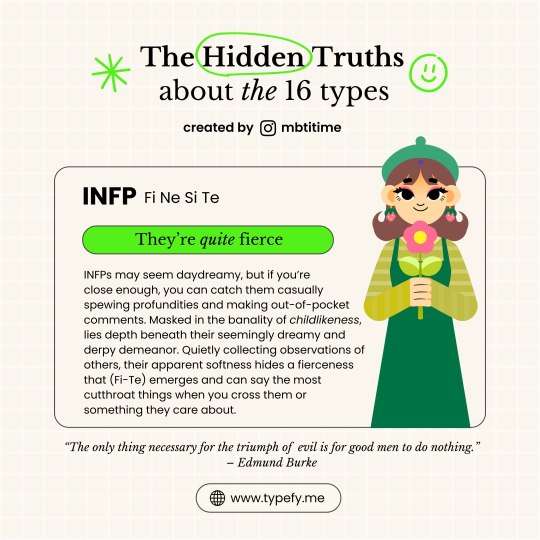




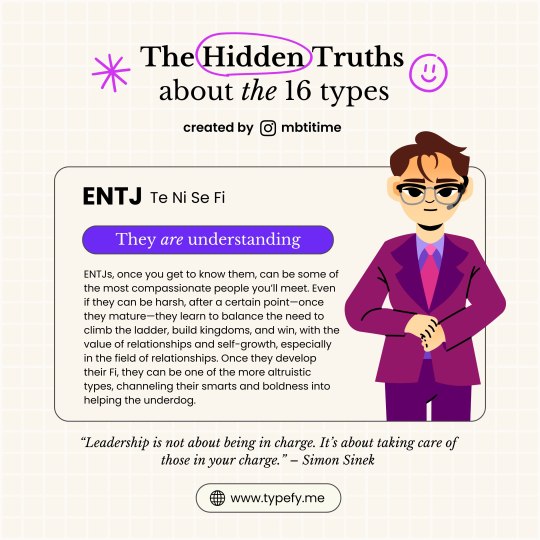





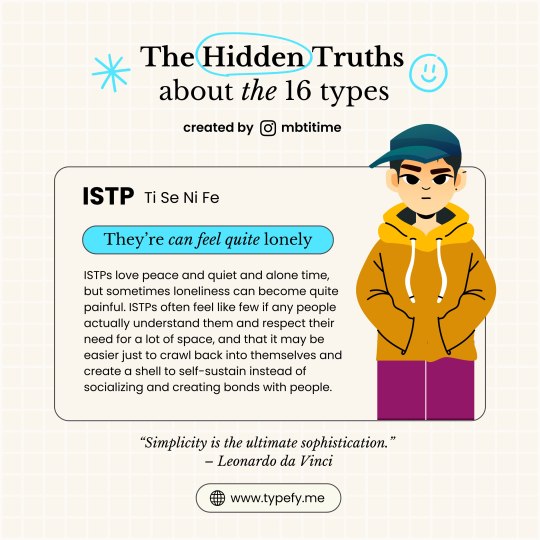

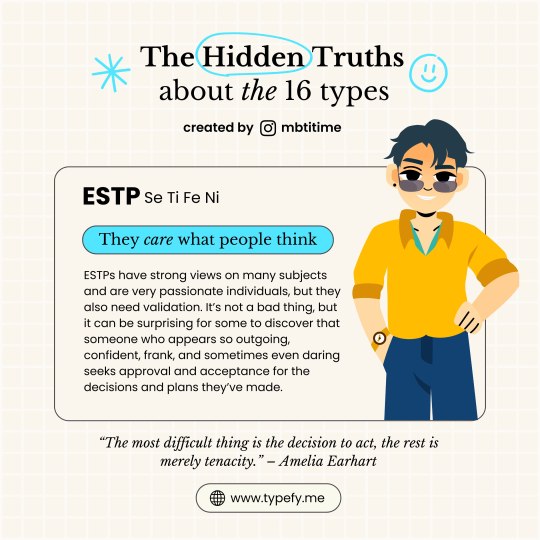
My Not-so-secret Secrets of the 16 types
Follow me on Instagram, Facebook, Twitter, YouTube and everything else @mbtitime and @typefy
#mbti#16 peresonalities#16 personalities#16 personalidades#infp#infj#enfp#enfj#intp#intj#entp#entj#isfp#istp#isfj#istj#estj#estp#esfp#esfj#carl jung#cognitive functions#myers briggs
551 notes
·
View notes